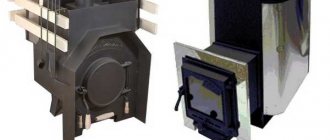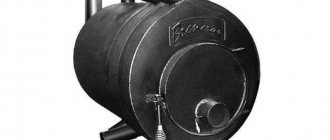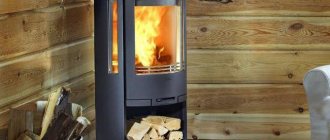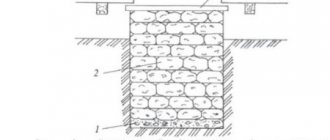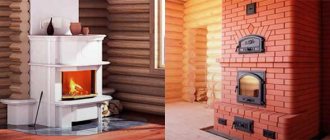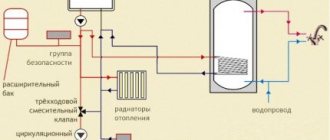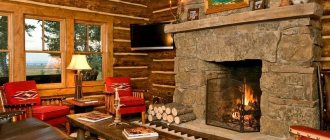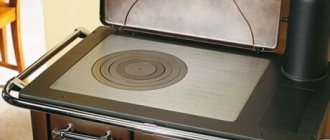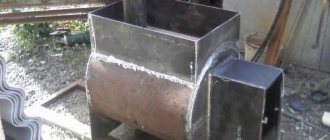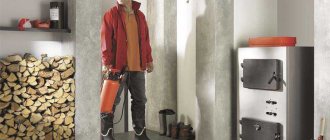Installation of a Buleryan stove requires a preliminary inspection of the room in which installation work will be carried out. It is necessary to take into account that such a device requires an influx of fresh air.
Schematic structure of the Buleryan furnace.
The location for the Buleryan stove is selected so that effective heating of the heated room is ensured.
In this case, care should be taken to ensure free access for cleaning and inspection. The floor under this device is made of non-combustible material.
How to install Buleryan? Installation of the Buleryan stove
Installing a Buleryan stove is not such a complicated procedure. Knowing the basic installation requirements, any man can cope with this task.
This article presents the basic requirements for installing a buleryan: how to make a chimney, what distance the stove should be from the walls and other safety rules.
So, to install Buleryan you will need:
stand (factory or self-made)
The stand for installing the buleryan is purchased based on the type of stove.
A stand under the Buleryan stove is necessary to ensure good air circulation in the room, which promotes convection and, accordingly, rapid heating.
The stand for the buleryan can be ordered directly from the factory where the heating device is produced, or it can be installed on your own base, for example made of brick.
A metal sheet is needed for the safe operation of the buller. The sheet is laid in front of the door if the floor of the room where the buleryan is installed is wooden or made of other flammable materials.
It is allowed to install buleryan on a tiled or stone floor without using a sheet.
Chimney for buleryan - the main installation factor
The most important element, without which the Buleryan boiler will not be able to work properly, is the chimney.
The chimney for a buleryan must be metal. It is impossible to connect a long-burning stove to a rough or brick chimney without a preliminary liner.
Why does a buleryan need a metal chimney?
Since the calorific stove is a long-burning unit and the bulk of the thermal energy is spent on heating the air, the temperature of the flue gases at the outlet of the stove is much lower than in simple potbelly stoves. This smoke temperature cannot warm up a brick chimney or chimney, resulting in condensation. Condensation in the chimney is the beginning of contamination of the pipe, and therefore a deterioration in draft.
Draft is very important for this type of stove. Only a straight metal chimney, well insulated on the street, the height of which is not lower than the ridge, can provide good draft for the buleryan.
Only such a chimney design will allow the long-burning buleryan to be used without problems with draft, without smoke and reverse draft.
Installing a stove using a stainless chimney is the best solution.
Stainless steel of acid-resistant grades AISI 304, 321 is durable: it is resistant to corrosion and aggressive acids. A stainless steel chimney is usually modular. A modular chimney consists of individual parts that are easy to install and fit into one another. To lay the pipe outdoors, a sandwich chimney is used - a pipe in a casing with thermal insulation.
Basic rules for correct installation of Buleryan:
- the stove must be located at a distance of 1 meter from walls made of flammable material. If the wall is plastered, then the distance can be reduced to 0.5 meters.
- For safe installation of the chimney to the Buleryan boiler, it is necessary to provide a non-combustible ceiling cut - penetration through the ceiling.
- To prevent moisture from entering the house, the outlet of the pipe on the roof is sealed with a roof or a flash master.
- the height of the chimney should rise above the roof ridge by 0.5 meters (in certain cases the height may be less).
- The outer section of the chimney is laid with sandwich elements (insulated thermal pipes).
- It is imperative to provide an element for collecting ash - an inspection, a tee.
By fulfilling all of the above requirements and recommendations for installing a buleryan, you can achieve trouble-free operation of the wood-burning heating system.
How to properly install Buleryan in a house, garage, greenhouse, installation of a chimney can be found in the Ochag online store.
Gas generator stove for a dacha Buleryan (Bullerjan)
- Content:
- Is it possible to heat a dacha with Buleryan Convection heating
- Heating a summer house with air ducts
- Possibility of cooking
To select suitable heating equipment for a summer residence, it is necessary to take into account several important requirements related to the features of operation and heating of a country house. The Bullerjan dacha stove fully meets all requirements: with its help you can quickly warm up an unheated building, cook food and heat water. With all these advantages, the stove is capable of operating in gas generation mode for 6 hours from one load of firewood.
Heat distribution
To keep the whole house equally warm, you need to place the buleryan in the central room. There should be a short path from it to other rooms.
There are several options for the role of the stove in heating:
- Auxiliary. You won't be able to give up gas heating, but you will be able to reduce consumption. If your region does not have very cold winters, you can completely heat your home with a stove. To do this, set the gas to the minimum setting so that condensation does not accumulate on the windows.
- Basics. Only for small houses with no more than 5 rooms. If the heated area of your home is more than 70 m2, additional measures will be required to allow air to be distributed throughout the home.
Is it possible to heat a dacha with Buleryan
Convection heating
Installing a Buleryan solid fuel stove at the dacha has certain disadvantages:
- Any obstacles in the way of convection currents reduce the thermal efficiency of the oven.
- Without additional structural changes, there is no possibility of heating adjacent rooms located on different floors or separated by walls.
Heating directly from the stove for heating a long-burning dacha Buleryan is suitable for owners of small houses. If you plan to heat a building that has many rooms that are not on the same floor, you will need to modify the design by connecting air ducts to convection pipes.
Heating a summer house with air ducts
To heat a 2-story country house, it will not be enough to install a gas generator stove in the building. Additionally, air ducts are connected to the convection pipes. Installation is carried out as follows:
- A special collector is installed on the convection pipes.
- The required number of air ducts are connected to the outlets located on the manifold of the air heating system of a two-story dacha using a Buleryan stove.
- The pipes are led into heated rooms and installed as low as possible to the floor level. A separate heated air supply hose is used for each room.
- The stove is installed in a separate room with sufficient ventilation.
Wood-burning pyrolysis stoves for the Buleryan dacha, with connected air ducts, are used to heat a building with several rooms and floors. The modified system manages to eliminate the shortcomings of convection equipment and increase heat transfer.
Possibility of cooking
Canadian wood heating stoves for long-burning summer cottages Buleryan are used both for heating and for cooking.
Models with a hob installed on top are designed for this purpose. The oven has enough power to heat 6 liters of water to a boil in about 15-20 minutes. Buleryan with a hob is available in several versions, differing in the number of burners. For convenience, it is better to use a two-burner model. Heating and cooking is carried out in normal combustion mode.
Heating a greenhouse with Buleryan
Reviews and experience in the practical use of Buleryan in a greenhouse prove that a gas-generating furnace is optimally suited for heating. But you will need to take care to comply with some measures that increase productivity and ensure safety.
The ability to maintain the required temperature in gas generation mode is especially necessary when heating a greenhouse in winter. One stack of firewood is enough to ensure uninterrupted operation for at least 6 hours.
It is important to ensure unhindered air convection in the greenhouse when heating with a Buleryan heat generator. The heating efficiency of the furnace is reduced if air flow is obstructed by partitions or other obstructions.
How to properly install Buleryan at the dacha
Design features allow Buleryan to be refined after installation in a wooden country house. The stove is lined with ceramic bricks. At the same time, heat transfer and energy efficiency remain at the same level, but a protective frame appears that prevents burns.
Some models are equipped with a door with a heat-resistant glass insert. After facing with brickwork, it will be possible to admire the fire during the combustion process.
Pros and cons of heating a dacha with Buleryan
When choosing heating equipment for your dacha, you will need to take into account both the advantages and disadvantages of various boilers and stoves that burn solid fuel. To make the right decision, you should consider the thermal characteristics of various types of heating devices.
What is better for a dacha - Buleryan or Butakov stove
The main difference between the Buleryan and Butakov stoves is the design of the convection tubes. In Buleryanov, the pipes come out of the body, which allows you to connect the equipment of the air heating system of several rooms of the dacha with a stove, without significant modifications or changes in design. Butakov’s convection outlets are located inside the body.
Varieties of execution
Professor Butakov's stove
Let's figure out the difference between Buleryan, Breneran, Professor Butakov's oven and what other types of Buleryan there are.
Buleryan is a brand from Germany. Under license, identical stoves are produced in Russia and they are called “Breneran”. There is no significant difference between these two ovens.
Professor Butakov’s stove has features and differences:
- Convection pipes are completely recessed into the body;
- The body is not barrel-shaped, but in the shape of a parallelepiped;
- There is an ash pan;
- There is a grate;
- The flat top surface allows you to heat food on it (although this will take a lot of time, because the body does not warm up very much).
The disadvantage of the design is the rotary valve. It is made in such a way that when adjusting its position you can burn your hands on the body.
Many people believe that the grate in convection ovens is an unnecessary part. Storing firewood needs to be done more often, although in Buleryany it burns almost without a trace.
Inquisitive minds invented aquabuleryan. However, Buleryan was originally developed as an air heating stove. It is not designed to heat water, which has a heat capacity 800 times greater than air.
Heat accumulators are used for greenhouses - this is a tuning designed to accumulate heat that is usually accumulated by walls. Curtain panels filled with gravel, pebbles, broken bricks, etc. They fit onto Buleryan convection pipes and follow the shape of the furnace walls.
Self-installation of the Buleryan stove
Installation of a Buleryan stove requires a preliminary inspection of the room in which installation work will be carried out. It is necessary to take into account that such a device requires an influx of fresh air.
Schematic structure of the Buleryan furnace.
The location for the Buleryan stove is selected so that effective heating of the heated room is ensured.
In this case, care should be taken to ensure free access for cleaning and inspection. The floor under this device is made of non-combustible material.
Manufacturing principles
It is quite understandable to want to try to make a buleryan oven with your own hands. You should immediately take into account that trying to build a furnace without experience in welding and plumbing is pointless. Even though a detailed description and drawing of the Buleryan stove can be easily found on the Internet.
If such a decision is nevertheless made, it is worth remembering that in a buleryan one of the most complex elements is the front wall with the door: the latter must ensure complete sealing, and its production will have to be ordered, otherwise you will not have to count on high-quality operation of the stove.
A list of necessary materials and tools can also be found on a specialized website or forum for stove makers.
Basic recommendations
Experts advise installing the buleryan on a metal stand, the height of which should exceed 20 cm. A brick base is allowed. The floor under the fire door should be protected with a metal sheet measuring 500x700 mm.
This stove operates due to the optimized fuel combustion process that occurs in it. Therefore, the operating rules for the stove provide strict requirements for the materials used for the construction of the chimney and its installation.
To ensure better circulation of air masses through the pipes, it is recommended to raise the stove 200 mm from the floor level, installing it on a base made of:
The Buleryan stove can be heated with almost any type of fuel except gaseous and liquid.
- slabs;
- bricks;
- stone;
- other non-combustible material.
Installation of this device involves the manufacture and installation of a 5 m chimney. For powerful models, you will need to make a 7 m chimney. This element is responsible for draft in smoldering mode. If this device smokes a little in gas generation mode, then there is not enough thrust.
The stove is installed at a distance of 60 cm from flammable materials. Before lighting the stove or putting wood in it, you should fully open the smoke damper and regulator. Next, the fuel is placed. After 20 minutes of burning, the stove switches to smoldering mode.
Installation work
The chimney is an important element of the Buleryan stove. The best option in this case is to install a heat-insulated chimney. This is due to the fact that the gases leaving the device have a low temperature. As a result, condensation forms. Insulated structures positively solve this problem. Households often prefer chimneys made of stainless steel with high heat resistance. Experts include the following advantages of this material:
- smooth surface;
- channel of optimal shape;
- high resistance to corrosion and temperatures;
- durability, low weight;
- easy installation.
Drawing of the Buleryan stove.
If the chimney is made of brick, then the thickness of its walls should be more than 120 mm. For concrete structures this figure is more than 60 mm, for metal structures - more than 1 mm. The chimney outlet is carried out on buildings with a roof made of non-hot material 1-1.5 m above the ridge. If this element is located inside the building, then it needs thermal insulation, which is carried out using mineral wool with a thickness of more than 200-250 mm.
In any case, horizontal sections longer than 1 m must be excluded. The diameter of chimneys should range between 120-150 mm. Experts do not recommend narrowing the diameter. If metal pipes are used, then their joints are sealed with non-flammable sealant.
At the base of this element there is a removable panel or hole with a door for cleaning. During the heating season, Buleryan is cleaned at least 2 times.
Technical points
The chimney can be placed inside or outside the building. External installation is used when installing a heating unit in a ready-made house. This technique involves venting the chimney through the wall of the room.
Experts include the following advantages of this technique:
Design and operating features of the unit.
- significant space savings;
- quick and easy installation;
- there is no need to remove this unit through the interfloor ceiling and roof of the building.
The disadvantages include:
- presence of a horizontal section;
- carrying out thermal insulation work;
- unoriginal appearance.
The internal placement of the chimney involves the passage of its vertical sections of stainless pipe inside the building. In this case, the chimney is installed near the internal walls and partitions. It is discharged through the interfloor covering and the roof using special pipes and roof penetrations. To do this, you will need the following tools: hammer, hammer drill, drills, hammer.
Due to the low weight of stainless steel structures, installation work is carried out without installing an additional foundation. The difficulties of such a procedure include ensuring its safe passage through the ceiling, including a safe and sealed chimney exit through the roof.
Experts include the following advantages of this technique:
- presence of good traction;
- providing additional heat from the chimney itself.
The disadvantages of the internal placement of the chimney include:
- carrying out complex installation;
- occupied usable area;
- ensuring the tightness of the chimney passage through the roof;
- provision of additional fire safety measures when the chimney passes through the interfloor ceiling and roof.
Pipe measurements using improvised means
Most often, the well-known caliper is used to measure the diameter of a pipe. But you may not have it, or if you do have it, it may not be possible to measure a large pipe diameter with it. In this case, the simplest set of tools and knowledge is used:
- flexible ruler (similar to the type of measuring tape used in sewing);
- roulette;
- school knowledge of the number Pi (it is equal to 3.14).
Using a similar set of tools, you can measure the diameter of not only a pipe, but also any other round object - a rod, column or garden bed.
We only need to make one measurement - determine the circumference of the pipe using a tape measure or flexible ruler. To do this, a measuring tape or tape measure is placed on the surface of the pipe in its widest part. The resulting circumference value should be divided by 3.14. For more accurate dimensions, use the value 3.1416.
It should be noted that imported supplies of pipes are accompanied by documentation that already indicates the pipe diameters in inches. To convert these values to centimeters, they are multiplied by 2.54. Similarly, to convert centimeters back to inches, multiply by 0.398.
A few nuances
The Buleryan stove is installed in a room whose floor, walls and ceiling are made of non-combustible materials. If they are present, you will need to apply thermal insulation, installing this device no closer than 1 m from walls and flammable surfaces such as wallpaper and wood. In this case, before firing the device, you will need to equip a free space with an area of more than 1.25 m.
It is allowed to reduce the distance from the Buleryan stove to flammable surfaces when using additional warm insulation according to the following scheme:
- up to 700 mm - when covering flammable materials with 25 mm thick plaster;
- up to 500 mm - when carrying out light insulation in 1 layer;
- up to 300 mm - when using double insulation from the 2 plates described above.
Instead of single light insulation, brickwork with a thickness of 55 or 110 mm is allowed - instead of double.
Unit design
The product is based on the design of a slow-burning steel convection-tube air boiler. Sometimes it is called a furnace-heater type device.
Buleryan consists of the following parts:
- Fireboxes. Heat exchangers are recessed into its walls by 2/3 of the diameter. In this case, 70% of the heat released in the firebox during smoldering is transferred from the air to the tubes. And 10% is distributed throughout the oven and heats the air.
- Doors that close tightly.
- Blower type pipe.
- Throttle. Using it, you can regulate the power of the device, and when it is closed, the oven goes out.
- Grate bars made of cast iron. When installing the product, they are placed below at a level slightly more than half of the firebox.
- Partitions located horizontally. It is welded from the top to a quarter of the height of the firebox and at the same time reaches the front side by a fifth of the entire size of the firebox. This jumper has holes with a total area of 7%.
Buleryan stove - long-burning design
The Buleryan boiler runs on any solid fuel (peat, firewood, sawdust, cardboard, paper, etc.), which makes it very practical and accessible to the population. It is not recommended to use coke, flammable liquids, or charcoal as fuel, as this can damage the boiler. This heating device is so safe to use that its installation is permitted even in fire hazardous areas such as garages and woodworking shops. Thanks to its unique design, the stove operates with incredibly high efficiency.
Principle of operation
Buleryan heats the room with streams of hot air, i.e. it works on the principle of a heater. Cold air is sucked into the oven through the lower pipes by convection. Since these same pipes pass through the firebox, the air instantly heats up to 120 degrees and forcefully comes out of the upper pipes.
Hot air quickly spreads throughout the room in which this device is installed. In the first compartment, the process of fuel combustion occurs with the subsequent release of furnace gases. The gas enters the upper chamber, where it burns out safely. Thanks to this, the Buleryan stove has a high efficiency (75-80%) and is completely environmentally safe, since all harmful gases are burned out inside it. A properly adjusted stove does not even emit smoke.
Fuel consumption is slow and economical. It is necessary to add fuel 2-3 times a day. A fully loaded firebox can supply heat evenly for 8-12 hours . The power regulator located on the door of the fuel chamber and the gasifier regulator located on the smoke pipe allow you to set the required temperature and control the process of heat release. The main part of the heat (90%) is released by streams of hot air through the upper pipes of the device, and only 10% is radiated by the stove itself. Therefore, its surface almost never gets hot.
Buleryan is a long-burning, volumetric stove, i.e. it is designed for a certain volume of the room in which it will be installed. The smallest stove in the Buleryan line is capable of producing 4.5 cubic meters of hot air per minute. Heating devices of this series have different sizes, depending on the thermal power and are designed to heat rooms with a volume of 100 to 1000 cubic meters. In terms of quality and efficiency, the Buleryan stove is far superior to traditional stoves and heaters that are expensive to install. Considering that the efficiency of a simple stove is only 3-7%, then using a Buleryan boiler will reduce your fuel costs by 10 times.
Furnace combustion modes:
- intensive;
- smoldering. This mode is the main one, since when the stove is used in intensive mode, the device wears out quickly and, as a result, the stove begins to consume fuel like an ordinary potbelly stove.
Advantages:
- autonomy, i.e. complete independence from external power sources (gas, electricity); high efficiency - 80% efficiency, uniform heating of the room, work on one load for up to 12 hours;
- large selection of models;
- ease of installation and maintenance;
- since the fuel burns out almost completely, it is recommended to clean the device only for preventive purposes;
- wide scope of application - private homes; cottages; country cottages; greenhouses; commercial, utility and industrial premises.
Flaws:
- Lack of a hob, i.e. it is impossible to cook food on such a stove;
- the Buleryan boiler requires constant loading, since it is completely devoid of inertia; when not in operation, it practically does not retain heat);
- unpresentable appearance. Although, if desired, it can be stylized with stones or some other home accessories;
- open combustion chamber. When the stove is operating, the air humidity in the room decreases, which can negatively affect people's well-being, so you should consider purchasing a humidifier.
Depending on the modification of the Buleryan stove, the price varies from 9,000 to 47,000.
The Buleryan boiler is made using the latest technology from thick high-quality steel and is practically resistant to burning.
Installation
When choosing a room to install a Buleryan stove, you should take into account that this device needs a constant supply of fresh air .
The location is determined taking into account the most efficient heating of the building. The stove is mounted on a stand, at least 20 cm high, made of non-flammable material (metal, brick, stone, etc.). A 0.5-0.7 m sheet of iron is placed on the floor near the fire door.
Installation and operation of Buleryan requires a chimney with a height of 5 m, and for more powerful models - 7 m. The best option is to install a heat-insulating chimney. This is explained by the fact that when leaving the device, the gases have a low temperature, as a result of which condensation forms. Thermal insulation of the chimney easily and successfully copes with this problem. Often homeowners install a stainless steel chimney with increased heat resistance.
The advantages of this material are as follows:
- Easy installation;
- light weight, durability;
- smooth surface;
- optimal channel shape;
- resistance to temperature changes and corrosion.
If a brick chimney is installed, the wall thickness should not be less than 12 cm. The diameter of the chimneys is 12-15 cm; it is not recommended to narrow it.
The distance from the device to flammable furnishings must be at least 0.6 m.
By installing Buleryan at home (at the dacha, in the garage), you will not only save your money, but also free yourself from all further costs for its maintenance.
Positive and negative aspects of the device
Breneran is a successful design that runs on solid fuel. It has many advantages:
- The housing serves as a forced convector through which all the oxygen in the room passes. In this case, air exchange is carried out naturally - due to the different densities of heated and cool air.
- You can burn peat briquettes, logs, waste from the paper and woodworking industries.
- High efficiency of the stove - it reaches 80%.
- Drawings of this heating device are widespread and can be found without much difficulty on the World Wide Web.
- The materials and equipment for installing the product are quite simple and are not very expensive. You will need a welding machine, a pipe bending device, metal sheets and stainless steel heat exchangers.
- The installation of the equipment itself, as well as the principle of its operation, is quite simple.
Disadvantages of the design
Buleryan has no visible negative sides. These devices are called “furnaces without flaws.” But if you understand the design well, you can still find negative aspects:
- Burning coal in a stove may damage the device. The use of flammable liquids and gases is also prohibited.
- The operating principle is based on the combustion of wood and paper. In this case, reaction water is released, which is formed during the breakdown of molecules of living organisms.
Sellers, when advertising breneran, say that when burning the tree does not form ash, but it is present in the wood initially. Therefore, ash particles fly into the chimney pipe.
When organic matter decomposes, hydrocarbon radicals are released, which reduce the efficiency of the stove by 6%. This is a small number, but radicals are quite dangerous for heating devices in everyday life.
The resulting water after the reaction precipitates as condensate. Moreover, this is not just a contaminated liquid, but a mixture of ash particles and a thin film rolled into a lump. The resulting toxins fall into the sump and have an unpleasant odor. This “water” always needs to be taken out somewhere, because it cannot be poured into the garden - otherwise the soil will be poisoned. In connection with this not very pleasant phenomenon, a heating device is often used in greenhouses, where the soil must be renewed annually.
How to install a Buleryan stove in the country?
“Here is part two about basic work at the dacha during vacation. This second part is devoted to the installation of the stove and chimney.
For almost six months I studied reviews on the Internet about the installation of various types of stoves and chimneys in dachas and country houses. After much thought, I came to the conclusion that Breneran (Buleryan) 01 is suitable for me. I also finally decided that I would install a chimney exclusively of the “sandwich” type.
The choice of model 01 was due to the fact that there are still uninsulated rooms in the house (non-residential for now), which means that more powerful heating will be required. Accordingly, I took it with a reserve of power (as, indeed, many recommend). The main thing was to find the most optimal place to locate the stove in the house. Such a place was found, and I began to calculate how exactly to route the chimney through the wall and how to generally choose the type of chimney.
After some time, I decided (with the help of consultations on the Internet) that this installation of the stove and the outlet of the chimney outside would be the most acceptable for me: https://foto.rambler.ru/public/meresiga/_photos/buler0/buler0- web.jpg I decided to install the stove and chimney myself while on vacation. Luckily there will be enough time and beer too. I also doubted for a long time whether I could unload the stove from the car myself, bringing it to the dacha after purchase. After all, the stove weighs a little more than 100 kg. However, everything went fine. When I bought the stove, they loaded it into the trunk of my Chevrolet Niva (after folding the seats and laying down the cardboard from the packaging box from under the refrigerator). And once there, I alone calmly pulled her out of there, lowered her to the ground, carried her home and installed her in her place.
If you liked the article, please share it
Previously on the topic:
Share
